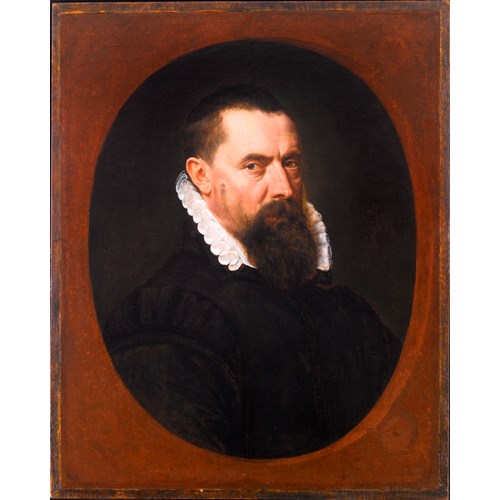William Simpson
Mongolia. Group near the Great Wall of China.
Date 1875
Epoque 1850-1900, 19th century
Origine England
Medium Pencil, Watercolour on paper
Dimension 17.2 x 12 cm (6³/₄ x 4³/₄ inches)
Mongol Princes who figured in the processions and ceremonies;
and many strange articles among which were ponies and camels, came to Peking through the Great Wall as wedding presents.’
-W. Simpson, Picturesque People: Being Groups from all Quarters of the Globe,1876.
The mounted pony is beautifully decorated with golden bells and a tassel, and patiently waits, ready to pass through the gate in the Great Wall on its way to Peking to be presented to the Emperor. Its rider, and another male figure behind, are wearing deels, a common outer garment in Mongolia. Their yellow colour, and the shaven head of the figure in the background, identifies them as Lamas. During the nineteenth century, it is believed that 45 percent of the male population of Mongolia were Lamas.
The blue of the accompanying woman’s dress is broken up by a colourful silk waistcloth or bous. She displays her ornate gold earrings and an opulent necklace, suggesting she is married - the jewellery would have been received as a dowry. Her costume belongs to one of many native groups that inhabit Mongolia, all of whom have their own traditional dress, with varied colours, styles, and ornaments. The predominant colours of yellow and red within the clothing and ornaments of the figures are symbolic, since they are considered to be sacred colours in Mongolia.
The present watercolour, dated 1875, was reproduced as a print in Simpson’s Picturesque People: Being Groups from all Quarters of the Globe, published in 1876. Simpson executed Mongolia. Group near the Great Wall of China using sketches from his trip to China three years before. The sketch would have been done ‘on the spot, and with all that scrupulous accuracy of detail for which his [Simpson’s] productions have always been so noted.’1
In 1872 Simpson embarked on a world tour, which saw him travel to Peking to record the marriage celebrations of the fifteen year old Emperor Tsai-Shun for the Illustrated London News in October that year. Whilst in Peking, Simpson took the opportunity of making a visit to the Great Wall of China. He reported the trip with great enthusiasm: ‘The Great Wall twists up and down the hills, like the wild vagaries of Chinese ornamentation of the writhing contortions of their gods... it is one of the Seven Wonders of the World which one has read of and wondered about in boyhood. Who has not wished to see such a monument, and wondered whether fate would ever give him a chance of doing so?’ In the text that accompanies the present work, he remarks that ‘The Great Wall of China itself is an evidence of the former power and greatness of the Mongols. The only object of that vast work was to keep them out of China, and it did not quite succeed, for more than one conquest has passed the wall.’2
On his return to England, Simpson exhibited paintings from his Chinese tour at Mr Thompson’s Gallery in Piccadilly, entitled ‘All Round the World’, and published his own account of the trip in Meeting the Sun: A Journey around the World in 1874.
1W. Simpson, Picturesque People: Being Groups from all Quarters of the Globe, 1876.
2ibid.
Date: 1875
Epoque: 1850-1900, 19th century
Origine: England
Medium: Pencil, Watercolour on paper
Signature: Signed and dated ‘Wm. Simpson 1875’ (lower left) and inscribed ‘Mongolians. Great Wall of China.’ (lower right), signed again ‘Wm. Simpson’ and inscribed as titled on The Fine Art Gallery label (on the reverse)
Dimension: 17.2 x 12 cm (6³/₄ x 4³/₄ inches)
Provenance: Fine Art Gallery.
Literature: W. Simpson, Picturesque People: Being Groups from all Quarters of the Globe,1876, where illustrated as a print, Plate 14, with the same title.
Plus d'œuvres d'art de la Galerie









